He’s no celebrity chef – but he sure is beginning to sympathise, as James May tells Ella Walker on the release of his debut cookbook.
James May is not on a mission to become a celebrity chef, regardless of the fact he has – against type, and against the odds – written a cookbook, and nabbed an Amazon Prime cookery show to go with it.
He has however, “become very sympathetic to them” as a telly species. “I used to occasionally watch a cooking programme and think, ‘Oh Gordon, stop being such a big diva, standing around swearing’. But now I’ve had a go at doing it, I realised what the problem is,” says Bristol-born May, 57.
That problem, he continues, is everyone on set sticking their oar in. “Everybody has a view on cooking because most people do it,” he says. “This is not true if you’re making a programme about science or engineering or car history, where you have some authority, but I’m working on a cooking show, where I avowedly can’t cook anyway, so everybody is part of the advisory committee and it does get annoying, quite quickly.”
Admittedly, watching the series back, he says he comes across “quite bad tempered, which I never am normally. I’m slightly ashamed of it,” he adds, “but that’s what happens when you try and cook on TV.”
The book itself – Oh Cook! – is less fraught (although May does share his ire for chefs who go on about using ‘freshly ground pepper’ – “You don’t need to say it EVERY time,” he says with a sigh). In essence, Oh Cook! is “not about learning recipes. It’s about learning the basics,” which you can then apply to everything else. After all, “once you can roast a chicken, you can roast anything.”
He says it’s “not for accomplished chefs, or celebrity chefs or people who collect recipe books. This is a book designed to be propped up on the worktop and used like a Haynes Manual for beginners, and once you’ve made the stuff in this book, you should give it to Oxfam and move on.”
Top of page picture credit Pavilion/Will Fisher/PA
Above picture credit Pavilion/Martin Poole/PA
Had there not been a lockdown though, the book probably wouldn’t exist at all. “I’m very good at putting off writing, because I find it quite painful,” says May ruefully. “I couldn’t go anywhere or do any of the things I normally do to distract myself, like riding motorcycles and playing around and so on, so I sat at home and did this book.”
And like the rest of us, he also ended up doing far too much home cooking. “To the point that I was told by Sarah, my other half, to stop cooking because she was getting annoyed with me. “It’s very easy to do, get fat and drunk because you’re stuck in the house – I tried to avoid doing that,” he adds. “I didn’t do so well at avoiding drinking all the wine, but I did manage to
eat quite healthily.”
The healthy eating has not quite translated to him joining the grow-your-own movement – yet. The former Top Gear presenter has a “little hobbity cottage” in the countryside in South Wiltshire, where he has recently embarked upon buying the field next door, “just because I’ve always quite fancied having a field”. Plus, “if I buy the field, it means nobody can build anything ugly on it”, he points out. To his happiness, it comes with a tractor. “I thought I might plough a little bit of it and have a go at growing potatoes or parsnips, something that I imagine would be quite easy – it probably isn’t.”
For a man who, in normal times, spends a lot of time on the road, he would, you’d assume, be a car snack aficionado – but no. Although when filming and not in lockdown, he’s all about packets of nuts and fruit, cereal energy bars and the odd packet of Liquorice Allsorts. “On our Grand Tour film shoots, we can be in the car for eight hours a day, or sometimes more, and yes we snack a lot,” he explains.
His Top Gear and Grand Tour days have not been entirely fuelled by Liquorice Allsorts though. “We’ve eaten everywhere,” says May, recalling the fanciest business hotels to little roadside shacks. “And often the roadside shacks are the more interesting thing. One of the standouts was a little place doing kebabs by the road in Jordan, and another kebab place at a market in Syria, and India is fantastic for that sort of thing. You just stop and find someone making dhal and chapattis, or a little tomato curry that costs 25p or something.”
It is, he says, “a privilege and it’s quite exciting. It possibly informs your palate in some way – but I’m in danger of sounding pretentious and like a foodie.” And he is anxious to not sound like one of those.
In fact, “somebody has already pulled me up on this book,” he says with a start. “I must’ve let my guard down.” Turn to the black pudding hash recipe and the first word of the method is, ‘Blanch’. “That was a terrible word to use,” says May, genuinely disappointed in himself.
May grew up on Seventies fare: “A roast on Sunday. Quite a bit of fish. Egg and chips. Meat and two veg. The occasional Chinese takeaway – but that was a very rare treat. Macaroni cheese with sausages…” And he’s still partial to Spam, although rarely, and admits it is “a bit of a schtick” that’s become part of his brand. Hence why there’s a roast block of Spam recipe in Oh Cook!.
“I do have a secret fondness that goes back to when we used to make Spam and beans when I was a teenager,” he remembers. “It used to be a camping food staple and we used to do camping a lot when I was a child, so it’s partly sentimentality, plus Spam is a funny word. And the block of Spam is funny. [And] the tins are beautiful.”
While there are more Grand Tour episodes ahead, May has – alongside his newfound telly cheffing career – just bought “half a pub”. He’s now the co-landlord The Royal Oak in Swallowcliffe (near his cottage), after its fate appeared to be in peril. “I thought, ‘I really like this pub’,” he explains, and so helped save it. “I don’t want to be in a village where there isn’t a pub within walking distance, that would make life utterly pointless.” And no, he won’t be found in chef whites out the back.
Oh Cook! 60 Easy Recipes That Any Idiot Can Make by James May is published by Pavilion, priced £14.99. Photography by Martin Poole..
Words by Ella Walker, PA
Pavilion/Martin Poole/PA
Chilli beef stir-fry, serves 4
INGREDIENTS
- 1tbsp sesame oil
- 1tsp grated fresh ginger
- 2tbsp soy sauce
- 1 green chilli, finely chopped
- 450g steak, cut into strips
- 1 red and 1 yellow pepper, deseeded and roughly chopped
- 1 carrot, cut into thin strips
- 250g baby corn
- 200g mangetout, halved
- 300g bean sprouts
- 300g rice noodles
- Sweet chilli sauce, to drizzle
METHOD
- In advance: Put the oil in a large bowl. Add the ginger, soy sauce, chilli and steak strips. Mix up and leave in the fridge, covered, to marinate for at least 10 minutes. Half a day is even better.
- Later: Heat your wok (large frying pan if you haven’t got one. Why haven’t you got one?) until really hot.
- Remove the meat from the marinade and wipe dry. Reserve the marinade. Add the beef to the wok and stir-fry for five minutes.
- Now add the peppers, carrot, baby corn, mangetout, bean sprouts and the leftover marinade. Stir-fry for three minutes until everything is cooked but not soggy.
- At the same time, soak the noodles for four minutes (or however long the pack suggests), drain well and add to the pan.
- Toss well. Serve straight away, anointed with chilli sauce.
Pavilion/Martin Poole/PA
Lancashire hot pot recipe, serves 4
INGREDIENTS
- 4tbsp olive oil
- 12 lamb cutlets
- 2 medium onions, peeled and sliced
- 2–3tsp flour (optional)
- 750ml/11/4 pints/3 cups hot lamb or vegetable stock
- Leaves from 2 fresh thyme sprigs
- 2 large carrots, peeled and sliced
- 450g/1lb floury potatoes, such as King Edward or Maris Piper, sliced
- 2tbsp butter
- Salt ‘n’ pepper
METHOD
- Preheat the oven to 180oC/375oF. Put a large lidded casserole in the oven to heat up.
- Meanwhile, add the oil to a large frying pan and fry the cutlets on both sides to brown them off a bit. You might need to do this in stages depending on the size of your pan. Remove them from the pan with a slotted spoon and set aside.
- Now soften the onions in the same pan, but not too much – four to five minutes should be enough. Don’t let them brown.
- Take the hot casserole from the oven and chuck the lamb and onions into it. Stir in a couple of teaspoons of flour if you want a thicker sauce, and add the stock. Add the thyme leaves and a bit o’ seasoning. Put the lid on this lot and shove it back in the oven for around 30 minutes.
- Remove the casserole from the oven. Stir in the sliced carrots. Now layer the sliced potatoes over the top, so that they overlap attractively and cover the whole area. Put the lid back on and stick it back in the oven for an hour.
- Take it back out of the oven. Turn the oven up to 230oC/450oF. Dot the butter over the top of the potato layer, then put it back in the oven, without the lid on, for another 30 minutes, or until the potatoes are crisp and golden.
- Serve and talk about trouble at t’ mill.
Pavilion/Martin Poole/PA
Jam roly poly recipe, serves 4
INGREDIENTS
- Softened butter, for greasing
- 200g self-raising flour, plus extra for dusting
- 100g shredded beef (or vegetable) suet
- 1tbsp caster sugar
- Pinch of salt
- 150ml semi-skimmed milk or water
- 6–7tbsp raspberry or strawberry jam
METHOD
- Preheat the oven to 200°C/400°F. Butter a large sheet of baking parchment and set aside.
- Stir the flour, suet, sugar and salt in a large bowl until fully combined. Slowly stir in the milk or water to form a soft, spongey dough.
- Tip the dough out onto a floured surface and knead for a few minutes. Roll the dough out into a 22 x 32cm rectangle.
- Spread the jam onto the dough, leaving a 1.5cm border around the edge. Slightly dampen the border with water. Gently roll the dough up from the short end and transfer to the baking parchment, seam-side down. Wrap the roly poly in the baking parchment, making a long pleat in the paper to allow the pudding to expand as it cooks. Twist the ends of the parchment like a Christmas cracker and tie tightly with kitchen string, to seal the pudding inside. Repeat the wrapping process with a large piece of kitchen foil.
- Place the pudding on the roasting rack set inside the roasting tin. Pour boiling water halfway up the roasting tin, just to the base of the pudding, and cook in the oven for 30–35 minutes.
- Remove the pudding from the oven, unwrap the kitchen foil, then snip the string and unwrap the parchment. The pudding should be well risen and lightly browned in places. Don’t worry if the jam has made its way through to the outside of the pudding and ends up on your face.
- Place on a warmed serving plate and cut into thick slices. Serve with lots of custard.
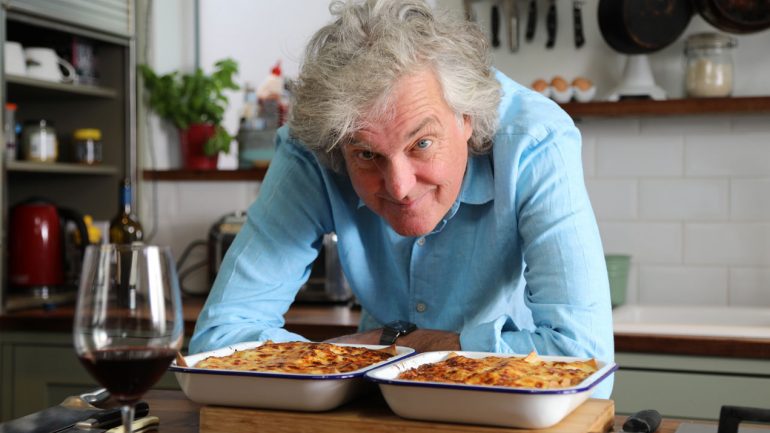
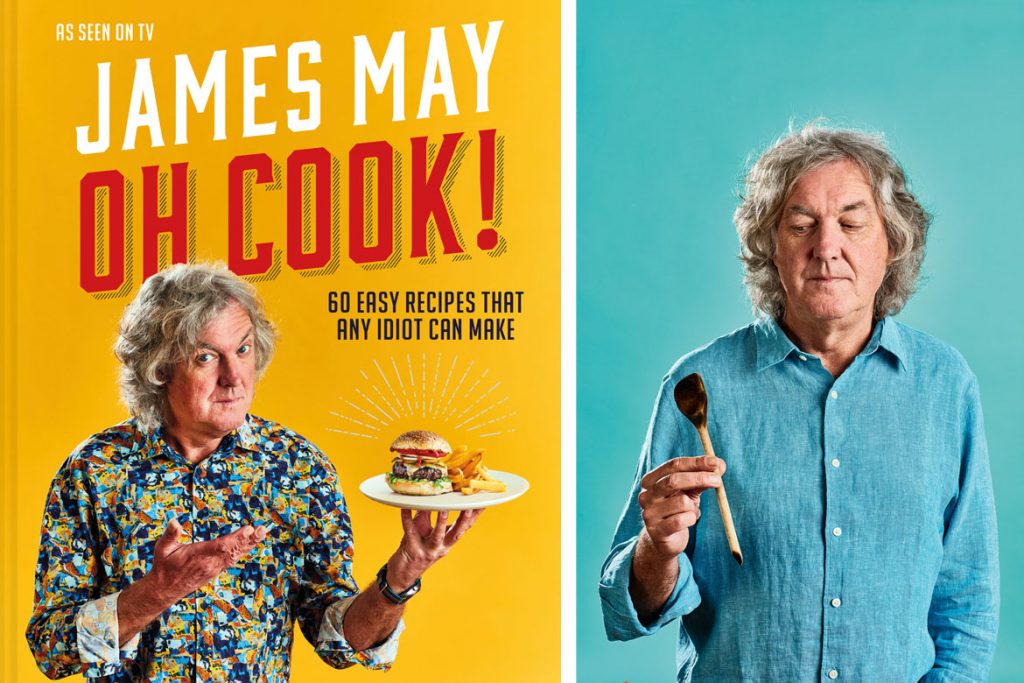
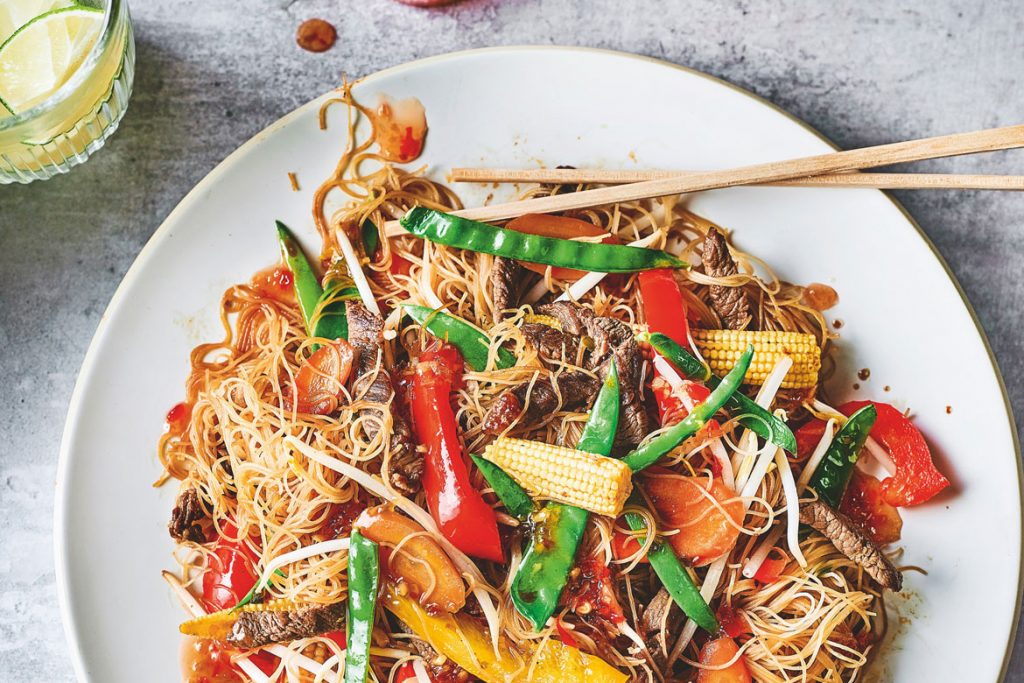
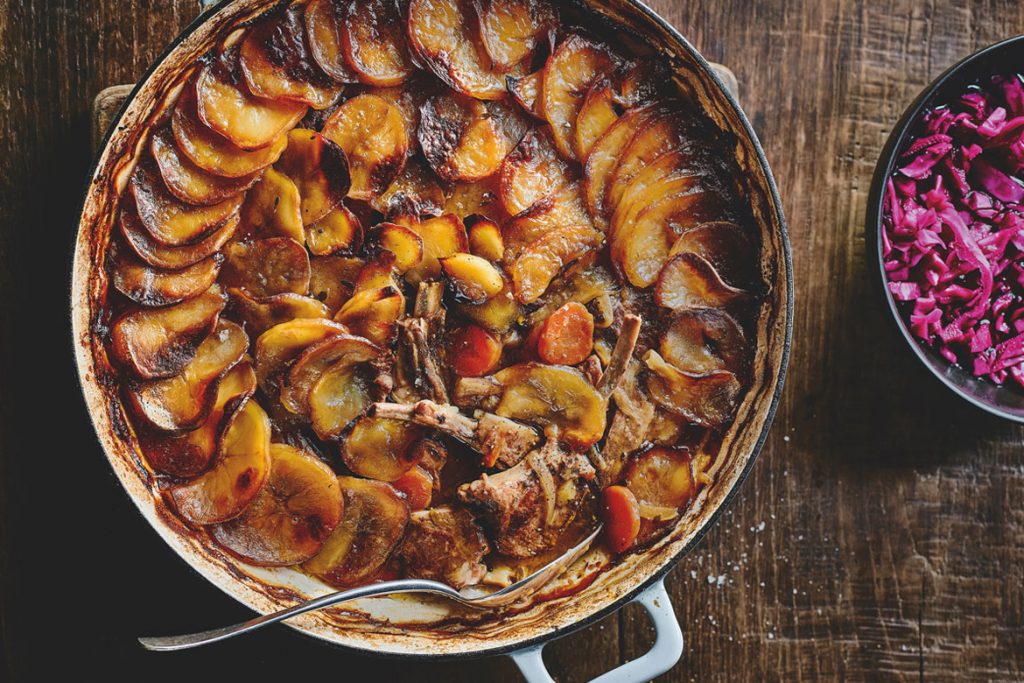
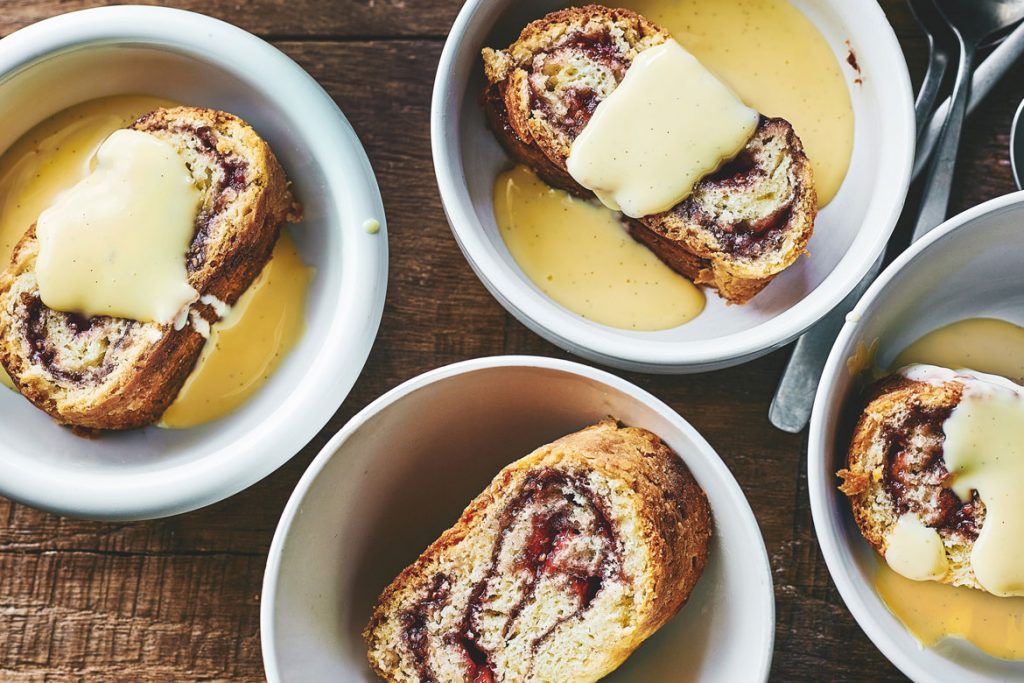

Leave a Reply